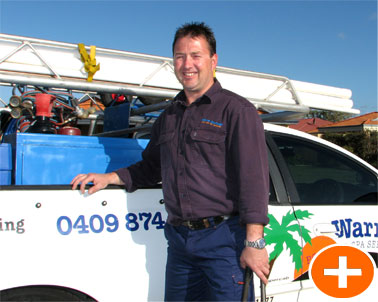Salt Water Swimming Pool Chlorinator Repairs Perth
Warm Springs Pool and Spa Repairs
0409 874 343

When to clean and service your swimming pool chlorinator
When to Clean the Chlorinator
A water chlorination system is designed to sanitize a swimming pool in the safest fashion available on the market. Salt water chlorination is one of the most popular means by which individuals sanitize their pools. Chlorinated water has a very benign and gentle effect on your body, face, skin, as well as your eyes. Essentially, a chlorinator goes through a systematic process in order to cleanse the water and add chlorine molecules to it. In this device, there are metal electrodes that take ordinary salt water, and convert it into chlorinated water by means of electrolysis. In some cases, however, a chlorinator cannot properly do its job because it has suffered a gradual build up of specific minerals, which leads to the increase in what is termed hard water. This then creates an obstacle for the electrolysis device, and obstructs its ability to produce chlorine. When this occurs, it becomes necessary to to clean this device in order to endure the production of chlorine in the pool.
How to Clean the Chlorinator
Using a few simple steps, you can in fact clean this chlorine system in your pool if it has become clogged with certain minerals.
The first step to cleaning this device is to shut down the pool pump, especially since you will be attempting to clean the electrolysis cell. Once you have accessed the pool filter, the next step will be to open its valve. This will help alleviate it of any air build up.
The next step will entail focusing on the electrolytic cell. Once you have accessed this particular device, you will have to remove the compartment that is actually encasing the cell itself. If you are unsure about this process, the manufacturer most likely included instructions on how to do this in a manual.
The next step in this process is to to dispense water into the plastic bucket. After you complete this step, obtain hydrochloric acid to the mixture in order to increase the relative acidity of the mixture, There should be a very specific ration, however, as you cannot simply add the HCL at your own discretion. The ration should be 10:1, ten parts water to 1 part hydrochloric acid. For example, if you were to add 20 cups of water, then 2 cups of HCL would be required. Always safeguard your hands during this stage of the process in order to protect your hands from the acidic nature of HCL.
The next step is to take the hydrochloric acid, and dispense it into the electrolysis cell casing until you have completely immersed the metal plates in the casing with the acid mixture. The empty plastic bucket will be needed to prevent spills. Once you have immersed the casing in this acid, place this casing into a bucket that is completely empty. Once the metal plates have soaked in acid determining where you see bubbles form. Wherever the bubbles form is where hard water has accumulated. once you have completed this step, take out the casing, fill the bucket 25% full with water then dispose of the HCL in the casing and pour it into the bucket. Then, clean this casing as much as possible with water. If there is any leftover acid contained within the bucket, place that into the second bucket. After this step is complete, the next step will be to add a single pound of soda ash into the full bucket and mix. This will help neutralise the acid so that you can dispose of it on the ground. Finally, you will need to place the electrolysis casing back in its original location, into the pool chlorinator. You can find directions for this in the manual for the pool.
Common Questions We Get:
Davey Nipper clock not working properly. Could you give me a quote please.
- Home
- How Do Swimming Pool Chlorinators Work?
- How do I calculate the amount of salt to put in my pool?
- Salt Water Swimming Pool Chlorinator Repairs Perth
- Salt Water Swimming Pool Chlorinator Models And Manufacturers
- Contact Us
- Login
- Sitemap
© 2025
